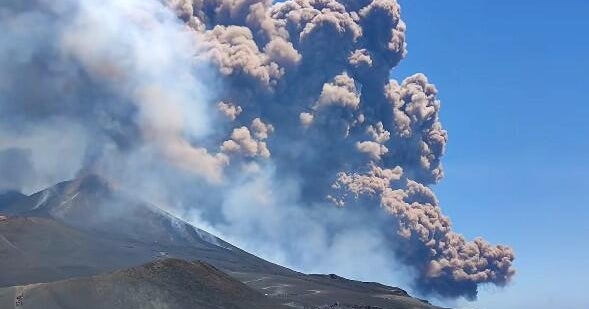The renowned Mount Etna, located on Sicily, Italy, has recently erupted, showcasing a spectacular display of hot ash and lava. This latest activity, marked by increasing explosive intensity, has raised attention but deemed safe for nearby residents. The eruptions, typical of the region, provide insights into the dynamic nature of volcanic activity in one of the world’s most studied volcanoes.
| Article Subheadings |
|---|
| 1) Overview of the Recent Eruption |
| 2) Characteristics of Mount Etna |
| 3) Historical Context of Eruptions |
| 4) Safety Measures and Monitoring |
| 5) Community Response and Future Outlook |
Overview of the Recent Eruption
On June 2, 2025, Mount Etna erupted, releasing a significant amount of hot ash and lava, confirmed by Italy’s National Institute of Geophysics and Vulcanology. The volcanic activity included “explosions of increasing intensity,” which the monitoring body described as “almost continuous.” Local time reports indicated that by noon, the explosive activity had transformed into a lava fountain, where infrared imaging captured dramatic visuals of lava cascading down the mountain’s slopes. The phenomenon was accompanied by expansive plumes of smoke rising into the clear blue sky, thrilling observers and scientists alike.
Despite the eruption’s scale, officials reported no immediate threats to the local population. Sicilians are well-acquainted with Etna’s explosive temperament, as the area has a history of both minor and substantial eruptions. The seismic activity continues to be monitored closely, ensuring that residents can remain safe while appreciating the natural spectacle.
Characteristics of Mount Etna
Mount Etna is recognized as the most active volcano in Europe and a leading stratovolcano globally. Stratovolcanoes are typically characterized by their conical shape, comprising successive layers of lava and ash from numerous eruptions over the years. Unlike other volcanoes that may go dormant for extended periods, Etna’s eruptions are frequent, often occurring at least once annually.
The geological formations of Etna are complex, comprising multiple craters and faults. These are a result of various eruptions throughout its history that shaped its current structure. Visitors to the region often marvel at the mountain’s unique landscape, interspersed with lush vegetation, archaic lava flows, and rich biodiversity—a testament to the resilience of life in a volcanically active area.
Historical Context of Eruptions
Mount Etna’s history of eruptions is well-documented, with accounts dating back to ancient times. Historical records indicate that the volcano has erupted on over 200 occasions since the monumental eruption in 1669. Each eruption has contributed to the mountain’s formation while simultaneously transforming the surrounding landscape.
One notable event occurred just over a year ago, where rare ring-like clouds, known as vortex bubbles, were observed emanating from its crater. Such occurrences contribute to the scientific community’s understanding of volcanic dynamics and provide an opportunity to study atmospheric phenomena related to explosive eruptions.
Safety Measures and Monitoring
Italy’s National Institute of Geophysics and Vulcanology plays a pivotal role in monitoring volcanic activity across the country, particularly with regard to Mount Etna. The organization employs various advanced technologies, including seismic sensors, remote imaging, and satellite observations, to track changes in volcanic behavior.
Residents are regularly updated about volcanic activity through reports and alerts issued by the monitoring agency. The government has implemented emergency protocols in the event of more severe eruptions, involving evacuation plans and communication strategies to ensure public safety. This proactive approach has fostered a culture of awareness and preparedness among the residents of surrounding towns.
Community Response and Future Outlook
The local communities around Mount Etna have demonstrated resilience and adaptability in the face of the volcano’s frequent eruptions. Over the years, inhabitants have learned to coexist with the volcano, developing practices and lifestyle adjustments that mitigate risks posed by volcanic events. The economies of these towns are often bolstered by tourism, drawing visitors eager to witness the volcanic spectacle while supporting local businesses.
Looking ahead, experts predict that Mount Etna will continue to erupt, albeit in varying intensities. As such, ongoing research and development in vulcanology will remain crucial to enhance monitoring efforts and understanding volcanic behavior better. Engaging the community in this scientific discourse can also empower residents, allowing them to remain informed and prepared while embracing the enchanting yet unpredictable features of their landscape.
| No. | Key Points |
|---|---|
| 1 | Mount Etna erupted, showcasing hot ash and lava on June 2, 2025. |
| 2 | The volcano’s activity is monitored by Italy’s National Institute of Geophysics and Vulcanology. |
| 3 | Etna is Europe’s most active volcano, known for its stratovolcano structure. |
| 4 | Historical eruptions provide insights into volcanic behavior and community resilience. |
| 5 | Safety measures and monitoring are integral to managing the risks associated with eruptions. |
Summary
In conclusion, the recent eruption of Mount Etna serves as a powerful reminder of the dynamism of volcanic activity and its impact on Sicilian life. While the eruptions carry inherent risks, the local community’s preparedness and the continuous monitoring by geological agencies highlight a collaborative approach to living harmoniously with nature’s formidable forces. Future studies will deepen understanding and help mitigate consequences, ensuring both safety and appreciation for this natural wonder.
Frequently Asked Questions
Question: What safety measures are in place for residents near Mount Etna?
Residents are informed of volcanic activity through reports from the National Institute of Geophysics and Vulcanology. Emergency protocols, including evacuation plans, are established to ensure public safety during significant eruptions.
Question: How often does Mount Etna erupt?
Mount Etna erupts frequently, with notable activity occurring at least once a year in recent years. Historical data shows the volcano has erupted over 200 times since 1669.
Question: What is the significance of Mount Etna in geological studies?
Mount Etna is considered a key site for the study of stratovolcanoes due to its frequent activity. Understanding its eruptions helps scientists gain insights into volcanic dynamics, ash dispersal patterns, and risks associated with living near active volcanoes.


